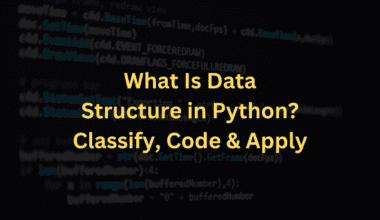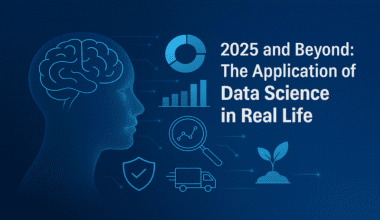Summary: Data Science and Data Analytics are both crucial for data-driven decision making, but they have distinct roles. This table breaks down the key differences, highlighting the focus (uncovering patterns vs. answering questions) and methodology (exploratory vs. structured) of each field.
Introduction
One of the most common questions that occur in the field of Data Science is – What is Data Analytics in Data Science?
Data Analytics is the process of analysing data to understand it and make decisions. Businesses use it to improve processes, understand customer behavior, and decide on marketing campaigns.
Data Analytics is an important tool for any business that wants to improve how it processes data and use it to make better business decisions. However, many organizations struggle with implementing Data Analytics solutions because they don’t fully understand what it is or the benefits it can provide.
In this post, I’ll explain what Data Analytics is and how it can be used to help your organization make better business decisions.
Why is Data Analytics Important?
Data comes in many forms, including transaction data, social media content, website visits, and other sources. Organizations collect this data from many different sources and use it for different purposes.
For example, companies may collect information from customers when they sign up for a service or make a purchase. This information is used to provide them with services and support related to their purchase or account.
However, analysing the data collected isn’t always easy, and businesses don’t always know what to do with the data once they have it. That’s where Data Analytics comes in. Data Analytics helps organizations analyse their data and make smarter decisions.
There are several benefits of using Data Analytics in your business. It can help identify problems with your business processes and allow you to find better ways to accomplish your goals.
It can also be used to identify patterns, trends, and growth opportunities so that you can focus your resources on these areas to grow your business. Finally, it can be used to reduce risks and improve security.
Click to know more: Data Analyst Interview Questions and Answers
Types of Data Analytics
Analysing data can help companies make smarter business decisions and help them become more competitive in the marketplace.
By analysing data about the effectiveness of their marketing campaigns, for example, businesses can discover which of their strategies are working and which ones are not. This can help them decide where they should focus their efforts to maximize their return on investment.
Descriptive Analytics
This type of analysis typically involves examining the past in an attempt to predict future outcomes. Businesses often use descriptive analytics to help them better understand their customers and their buying habits.
For example, a retailer might analyse customer data to determine which products perform best or what times of the day are most popular with customers. Companies use this information to enhance their marketing and operations strategies, driving sales and increasing customer satisfaction.
Diagnostic Analytics
This analysis aims to identify the root cause of problems for effective resolution. It also uncovers new opportunities that the company might pursue.
For instance, a company might use diagnostic analytics to find out why its products aren’t selling as well as they expected and discover ways they can address the issue before it becomes a bigger problem.
Predictive Analytics
This type of analysis uses historical information to make predictions about the future. It determines which products are most likely to succeed and predicts the timing of certain events.
For example, a company may use predictive analytics to help determine when the best time to launch a new product will be so they can take advantage of the most lucrative sales opportunities.
Prescriptive Analytics
This type of analysis identifies the best course of action to take to achieve the desired result. Companies frequently use it to optimize business processes and systems, improving efficiency and eliminating waste.
For example, a business might use prescriptive analytics to identify potential improvements they can make to their supply chain to improve delivery times and reduce expenses.
Difference between Data Science and Data Analytics with Example
Data Science and Data Analytics, while seemingly similar, have distinct approaches. This table highlights these differences, highlighting the focus, methodology, and desired outcomes of each field.
Click to know more: Data Analytics Tools for Data Analysts
Application of Data Analytics
Apply analytical methods to business transactions for the purpose of optimizing performance, reducing costs, and increasing revenue. This may include examining operational processes to identify inefficiencies and opportunities for improvements, reviewing business records to ensure compliance and identify fraudulent activity. The following steps for Data analysis can be considered important:
- Developing the process/structure of the Analytic solution.
- Identifying data needs and their sources.
- Preparing data sources for analysis.
- Cleaning data for analysis.
- Analysing the data to extract insights and produce actionable information.
- Reporting the results and providing recommendations.
Steps of Application of Data Analytics
Data surrounds us, but how do we extract its true value? Data Analytics offers a powerful roadmap to transform raw data into actionable insights. This process unfolds in a series of steps, from defining the question or problem to be addressed to visualizing the results for clear communication.
By following these steps, data can be transformed from a jumbled collection of numbers to a source of knowledge that drives informed decision-making.
Step 1 – Defining the Scope of the Analysis
The first step involves defining the scope of the analysis and developing the structure and process for the analytic solution. This may involve developing a model of the business process being analysed and identifying how the process will be optimized using analytic solutions.
Step 2 – Identifying Data Needs and Their Sources
Next, an analyst has to identify and capture the relevant transactional and operational data that is required to support the analysis. The type of data required will vary depending on the specific analysis being performed by the analyst.
In some cases, the relevant data may be contained in relational databases, spreadsheets, or flat files. In other cases, it may be necessary to develop customized applications to store and analyse the data.
Step 3 – Preparing Data Sources for Analysis
Once the data has been identified and captured, it must be prepared so that it can be used in the analysis. In many cases, the data will need to be restructured and filtered so that it conforms to the standard formats used by the analytical tools that are used to perform the analysis.
This step may require the help of subject matter experts who can help make sure that the data is formatted properly for use in a given analysis. The structured and cleansed data can then be used by the analyst in the subsequent steps of the Data Analysis process.
Step 4 – Cleaning Data for Analysis
Once the data has been prepared, it may need to be cleaned before it is used in the analysis. This may involve removing any unwanted records that are included as part of the source data so that only the desired records are used in the analysis.
For example, if the data is being analysed using an advanced analytics tool, there may be records that do not contain the desired information because they contain values that are considered outliers.
In this case, the records containing these unwanted values can be removed from the data set before it is used to perform the analysis.
Step 5 – Performing Data Analysis
The final step in the process is to perform the actual analysis using the data and preparing the results for presentation. Depending on the type of analysis being performed, the analysis may be performed manually or using an automated tool such as a spreadsheet application or an advanced analytics tool.
In some cases, it may be necessary to combine the results of multiple analyses in order to conduct a complete analysis of the data. For example, the data obtained from the network intrusion detection system can be combined with the results of other analyses to identify the root cause of the breach.
The data can then be presented to management so that they can identify the steps that need to be taken to address the risk and prevent future incidents from occurring.
Step 6 – Presenting the Analysis Results
Once the analysis is complete, the results must be presented so that the results can be understood by management and other stakeholders in the organization. The results of the analysis should be presented in a clear and straightforward manner that avoids using complicated terminology or excessive detail.
This will make it easier for non-technical members of the organization to understand the results and take appropriate actions based on the findings. Recommendations should also be presented along with a plan of action that will outline the steps that need to be taken based on the findings.
Data Analyst vs Data Scientist Salary
As the data revolution unfolds, two in-demand roles have emerged: Data Analysts and Data Scientists. Both are essential for extracting knowledge from data, but their career paths diverge. This section highlights the key differences between Data Analysts and Data Scientists:
Data Analyst Salary
- Average: The average Data Analyst salary in India ranges from ₹ 1.8 Lakhs to ₹ 13.0 Lakhs.
- Factors Affecting Salary: Experience, location, industry, specific skills (e.g., machine learning expertise), and the size of the company can all significantly impact a Data Analyst’s salary.
Data Scientist Salary
- Average: Data Scientists typically command higher salaries compared to Data Analysts. The average Data Scientist salary in India can range from ₹ 3.9 Lakhs to ₹ 28.0 Lakhs.
- Factors Affecting Salary: Similar to Data Analysts, experience, location, industry, and skillset all play a crucial role in determining a Data Scientist’s salary. Additionally, factors like possessing a postgraduate degree in a relevant field (e.g., statistics, computer science) and strong leadership or communication skills can further influence earning potential.
Techniques in Data Analytics
There are various analytical methods that can be used for performing Data Analysis. These Data Analytics techniques can be explained as follows:
Regression Analysis
This is a statistical technique that is used to model the relationship between two or more variables. It is a technique used to examine trends in data and predict outcomes based on existing trends. For example, it can be used to determine the impact of a marketing campaign on product sales.
Factor Analysis
It can be used to measure the level of association between different variables in a dataset. Factor analysis can be used to identify key factors that drive customer satisfaction in a particular company. It can also be used to identify the factors that are likely to impact consumer purchasing decisions in the future.
Cohort Analysis
This is a statistical technique that can be used to analyse the data from different groups of customers or patients in order to understand which factors influence their buying decisions.
For example, a company can use cohort analysis to determine which factors are important to the customer age group that is more likely to buy its products.
Monte Carlo Simulations
This technique is a type of stochastic simulation that can be used to create estimates by simulating many different scenarios and analysing the results of each scenario to predict the likelihood of a particular outcome occurring.
For example, it can be used to determine if the company is at risk of failure due to a potential market decline. It can also be used to evaluate the effectiveness of a new product launch or marketing campaign.
Time Series Analysis
This is a type of statistical analysis that can be used to analyse patterns over time. It can be used to identify seasonal sales patterns that affect customer demand for a particular product.
It can also be used to predict market trends in order to determine whether demand for a product is likely to increase or decrease in the near future.
Data Analytics Tools
From wrangling messy data to crafting compelling visualizations, the Data Analytics tools empower Data Analysts to uncover hidden patterns, answer complex questions, and communicate results effectively. Let’s delve into the treasure chest of data analytics tools and explore how they can unleash the power of data!
R Programming Language
R is an open-source programming language that can be used for a wide range of Data Analytics applications. It is widely used by Data Scientists for performing statistical analysis. It can analyse large datasets quickly and perform sophisticated Data Analysis tasks with ease.
Python Programming Language
Python is another popular programming language that can be used for a variety of applications including Data Analytics. It is a general-purpose language that is easy to learn and can be used to perform complex Data Analysis tasks in a relatively short time. Python can be used in both interactive and batch modes for Data Analytics purposes.
SAS Programming Language
SAS stands for Statistical Analysis System and is a software suite that can be used for performing advanced analytics such as data mining and predictive analytics.
It is generally used for analysing data in real time but can also be used for storing and analysing data in batches as well. It is a commercial product that is available on a subscription basis from SAS Inc. (formerly known as SAS Institute).
SQL
SQL is a relational database language that is commonly used for data management and analytics purposes. It is an ANSI standard language and is supported by all major database management systems.
It can be used for creating and maintaining databases as well as performing basic and advanced query operations on them.
Machine Learning Tools
Machine Learning tools can be used to develop custom models that can be used to make predictions about future trends based on the historical data available.
They can incorporate many different techniques including decision trees, regression, clustering, anomaly detection, etc. and they are widely used in industries such as finance, retail, healthcare, manufacturing, transportation, etc.
Click to Know More: Remote Data Analyst Jobs, Salary, Employment
Parting Thoughts!!
Hence, from the above blog post, it can be concluded that Data Analytics plays a very vital role in business organizations today and the tools that are used for performing analytics are constantly evolving and improving with time.
This, in turn, makes the data that is analysed much more reliable and provides better insights which can help businesses make more informed decisions.
Individuals aspiring to a technical career in the Data Science field can pursue various Data Science and Data Analytics online courses to gain the necessary skills and expertise required to perform Data Analytics effectively.
They can opt for a Data Analytics course online which will help them gain the needed skills and knowledge required to become a successful Data Analyst.
Frequently Asked Questions
Is Data Analytics a Stepping Stone to Data Science?
Data Analytics provides a strong foundation for Data Science. By honing your skills in data cleaning, analysis, and visualization, you gain transferable knowledge crucial for building models and solving complex problems with data – hallmarks of Data Science.
How Does Data Analytics Contribute to Data Science Projects?
Data Analytics plays a vital role throughout the Data Science lifecycle. It helps define the initial questions, clean and prepare data for modelling, and interpret the results of Data Science models. Essentially, Data Analytics provides the groundwork for Data Science to flourish.
Can Data Scientists Perform Data Analytics Tasks?
Absolutely! Data scientists possess the skills of a data analyst, but their expertise extends further. While they can handle data cleaning and visualization, data scientists delve deeper into building models and using advanced techniques to extract knowledge from data.







